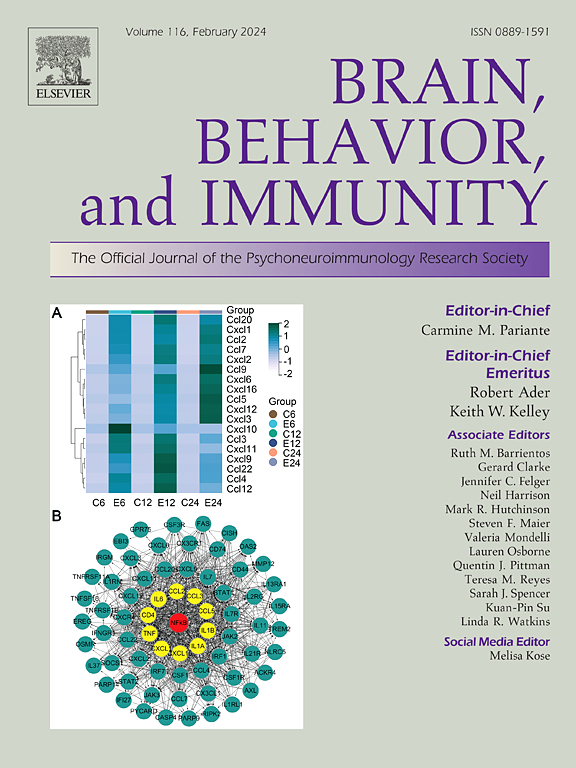CXCL1-CXCR2 signaling mediates the activation of microglia in the nucleus tractus solitarii to promote pancreatic cancer-induced pain
IF 8.8
2区 医学
Q1 IMMUNOLOGY
引用次数: 0
Abstract
Pancreatic cancer can cause severe abdominal pain. Its peripheral mechanisms have been studied, but the role of central nervous system in pancreatic cancer-induced pain remains unclear. The current study focused on the nucleus tractus solitarii (NTS), a primary center of visceral sensation located in medulla oblongata. Neurons in the NTS were activated and exhibited increased excitability among mice with pancreatic cancer-induced pain. Transcriptome analysis revealed that pancreatic cancer-induced pain was associated with neuroinflammation in the NTS, involving changes in chemokines expression. In mice with pancreatic cancer-induced pain, the microglia activation in the NTS was observed, characterized by increased cell density and decreased process number and length, while injection of microglia inhibitor minocycline in the NTS alleviated pancreatic cancer-induced pain. The cytokine CXCL1 and its receptor CXCR2 were upregulated in the NTS of mice with pancreatic cancer-induced pain. Blocking CXCL1-CXCR2 signaling by injection of CXCL1 neutralizing antibody or CXCR2 antagonist SB225002 in the NTS of mice with pancreatic cancer-induced pain alleviated abdominal hypersensitivity and hunching behavior, and also reversed the activation of neurons and microglia. Additionally, injection of recombinant CXCL1 in the NTS of sham-operated mice induced abdominal pain, and activated the neurons and microglia. In summary, our study highlights the critical role of NTS microglia activation mediated by CXCL1-CXCR2 signaling in pancreatic cancer-induced pain.
CXCL1-CXCR2信号介导孤束核中的小胶质细胞活化,从而促进胰腺癌诱发的疼痛。
胰腺癌可引起剧烈腹痛。对其外周机制已有研究,但中枢神经系统在胰腺癌诱发疼痛中的作用仍不清楚。本研究的重点是位于延髓的内脏感觉主要中枢--脊髓束核(NTS)。在胰腺癌诱发疼痛的小鼠中,NTS的神经元被激活并表现出更高的兴奋性。转录组分析表明,胰腺癌诱发的疼痛与 NTS 的神经炎症有关,涉及趋化因子表达的变化。在胰腺癌诱发疼痛的小鼠中,NTS中的小胶质细胞被激活,其特征是细胞密度增加,过程数量和长度减少,而在NTS中注射小胶质细胞抑制剂米诺环素可减轻胰腺癌诱发的疼痛。细胞因子CXCL1及其受体CXCR2在胰腺癌诱发疼痛的小鼠NTS中上调。在胰腺癌诱发疼痛的小鼠NTS中注射CXCL1中和抗体或CXCR2拮抗剂SB225002来阻断CXCL1-CXCR2信号传导,可减轻腹部超敏反应和驼背行为,并逆转神经元和小胶质细胞的激活。此外,在假手术小鼠的 NTS 中注射重组 CXCL1 会诱发腹痛,并激活神经元和小胶质细胞。总之,我们的研究强调了 CXCL1-CXCR2 信号介导的 NTS 小胶质细胞激活在胰腺癌诱导的疼痛中的关键作用。
本文章由计算机程序翻译,如有差异,请以英文原文为准。
求助全文
约1分钟内获得全文
求助全文
来源期刊
CiteScore
29.60
自引率
2.00%
发文量
290
审稿时长
28 days
期刊介绍:
Established in 1987, Brain, Behavior, and Immunity proudly serves as the official journal of the Psychoneuroimmunology Research Society (PNIRS). This pioneering journal is dedicated to publishing peer-reviewed basic, experimental, and clinical studies that explore the intricate interactions among behavioral, neural, endocrine, and immune systems in both humans and animals.
As an international and interdisciplinary platform, Brain, Behavior, and Immunity focuses on original research spanning neuroscience, immunology, integrative physiology, behavioral biology, psychiatry, psychology, and clinical medicine. The journal is inclusive of research conducted at various levels, including molecular, cellular, social, and whole organism perspectives. With a commitment to efficiency, the journal facilitates online submission and review, ensuring timely publication of experimental results. Manuscripts typically undergo peer review and are returned to authors within 30 days of submission. It's worth noting that Brain, Behavior, and Immunity, published eight times a year, does not impose submission fees or page charges, fostering an open and accessible platform for scientific discourse.

 求助内容:
求助内容: 应助结果提醒方式:
应助结果提醒方式:


